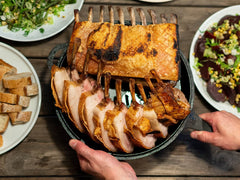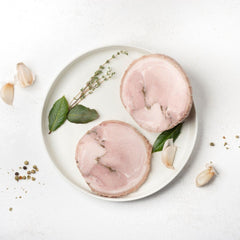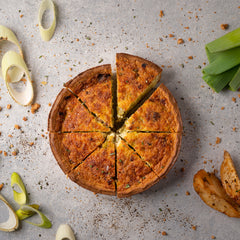The art of food presentation goes way beyond garnishing. It's a visual way to introduce the meal's culinary story and give the diners a glimpse of the flavor that awaits them. If you've ever heard the phrase “one eats with his eyes first”, in the culinary world, this statement is unequivocally true. If there's one thing hospitality experts agree on, it's that food presentation is crucial to the entire dining experience.

Designed by Freepik
The aesthetic arrangement of food on the plate is a chef's silent message to the diners, inviting them to savor not just the taste but the culinary journey. If you're finding food presentation difficult, you'll want to read this article to the end, as we will unearth everything you'll need to know to make your food presentation a masterpiece.
Importance of visual appeal in food preparation
Having known that we first eat with our eyes before our mouth, it's a no-brainer why visual appeal is as crucial as the food itself. Here are some reasons why it matters:
Influence diners' perception and acceptance of food
The visual presentation of the food is the first thing guests will notice. A well-presented dish often entices eaters and leaves a memorable first impression. Research has shown that plating food in an aesthetic manner makes diners see the food as more sophisticated and, consequently, are ready to pay more.

Enhanced Appetite
Colors, shapes, and food arrangements can add energy and trigger hunger. Bright colors like red, yellow, and green revive appetite and present food as natural. Also, complementary colors add a visual appeal to the food. When these colors are blended properly, it raises diners' anticipation of the food, and they are ready to eat more. The color of your plateware also highly affects the overall presentation which we will address in this article.
Reflects Quality
The dish's visual appeal speaks volumes about the food preparation, and the level of care to execute the dish. Also the environment where the guest is, the cleanliness of the linens, glassware or silverware, are elements that will tell a lot about the hygiene of the food and venue. Even if it's a high-end restaurant and food is presented in a shabby manner, or the venue is not well looked after, then diners will go with the notion that the dish was prepared in an unsafe environment using low-quality ingredients and that the standards of the venue are low.
Marketing and Social Shares
We are in an age where a simple post on the internet can go viral and gather over a million views in a few hours. Suppose visitors love their food presentation and dining experience. In that case, they are most likely to take pictures of the food or environment to post on their social media handles, which has a high possibility of attracting first-time visitors and repeat customers if the post goes viral. For the hospitality industry, this is earned marketing and low-cost advertising spreading across the social media network.
Techniques to Enhance Food Presentation
Whether you're a professional chef or a home cook, your plating process can make a big difference in how it is received. Here are some top food plating techniques to enhance food presentation:
Landscape plating

Designed by Freepik
Landscape gardeners inspire this style of plating. It comprises long and low placement of food across the plate. It also gives a natural and artistic look to dishes, enhancing the flavor and texture of the ingredients. This style can be used on any dish, both main dish, appetizers, and desserts. To get the best output, cut each item into bite sizes.
Classical plating
It is a traditional and symmetrical plating technique that allows diners to see the elements on the plate vividly. This method uses starch, vegetables, and the main for the food arrangement. You'll have to view your plate like a clock. Protein should be placed between 3 and 9 o'clock, carbohydrates/starch between 9 and 12, and vegetables should be placed between 12 and 3.
Free form plating

Designed by Freepik
The free-form plating allows for a more relaxed and asymmetrical food placement. Unlike the classic plating, where each element has a specific place, the free form allows for creativity. You can use cooking methods like smearing, scattering, or stacking to create a visually appealing dish.
Food on organic material techniques
This food presentation style uses natural materials like wood, stone, and slate as plating devices. It gives a rustic and natural feel to the dishes. You can use this technique for different occasions so long the plating and materials are safe, clean, and suitable for the food.
The bathing technique

Designed by Freepik
The bathing technique presents the main dish in a pool of sauce or broth. This food plating style creates a more flavorful and eye-catching look for your dish and also the texture of the food. You can use the bathing technique for Tortellini with shellfish sauce or for a soup consommé, you can place your vegetables in the bowl and pour the soup broth at the table for a wow effect!
Creative Plating Ideas to Impress Your Guests

Whether you're serving up modest fare or fine cuisine, there's no one way to plate food. However, some important factors must be considered when presenting your food. But the rule of thumb is that the food's taste should match its looks. Here are the top food plating ideas that will help you plate food like a chef.
Tailor plating style to your evening’s concept.
You must give diners a more cohesive experience. Ensure your plating style matches your theme. If you have ethnic and casual dining, a hearty presentation using traditional dishware will be most suitable. For a fine-dining feel, using wares that exude luxury and affluence will be perfect, while for a family-style service, you can aim for colorful large plating. To get the most suitable plating for your party, you'll have to study your theme and guests to know what best fits.
Simplicity is key
One way to ensure simplicity is to pick one ingredient to be the spotlight on the plate. Clutters cause distractions, and most times, diners get confused about where to begin. To get this right, you should incorporate negative space. It will help draw diners' attention to the main element of the dish. Also, ensure that the plate complements the dish. Don't be under pressure to fill up the plate. You'll have to get different plates and proportions for different dishes.
Height and layers
Think of this like a landscape; placing elements at different heights adds depth to grab attention. For example, you can place mashed potatoes as your base and layer a piece of grilled chicken on top, then garnish it with steamed asparagus while standing upright. With this, you'll have starch at the bottom, protein in the middle, and vegetables upwards.
Tableware

Designed by Freepik
In French cuisine, the selection of tableware is vital to the overall presentation of the dish. Carefully choose plates, bowls, and platters that not only match but elevate the aesthetic qualities of the food. The design of the tableware is often minimalistic, directing attention squarely on the culinary creation itself. For your tablewares you can use white or light shades; they'll blend well with garnishes and sauces.
Use suitable tools
Using the right tools is crucial when plating food. It helps elevate the presentation of your dish to match the effort you've put into the meal preparation. Some of the common tools you'll need include a precision spoon, sauce squeeze bottle, tweezer, brush, round cutters, and spatula. These tools allow for greater control and finesse.
Utilizing Colors and Textures in Food Presentation
Colors and textures elevate the dining experience. When applying to food placement, you must ensure that there's a balance. Aside from this, it would be best if you considered contrast. When contrasting colors are used, the presentation stands out—for example, using a bright red color on a bed of green lettuce. There are no rules. You're free to use any style, seasonal colors, or color wheels, but you must ensure that the colors are harmonious, i.e., they blend perfectly. Garnishes add texture, and cooking techniques like grilling or broiling can add texture to your dish.
The Role of Garnishes and Edible Decorations
Add textural contrast and flavors: Some garnishes, such as crouton on soup or fried onions and shallots, toasted nuts on salad, add textural contrast that makes food taste better. Also, garnishes like fresh herbs or citrus zest add a complementary taste to the dishes.
Signals ingredients and culinary creativity: Garnishes give visual clues about the ingredients used to prepare the dish. For example, if a diner picks up the menu and sees Rosemary on a lamb dish or a mint leaf on a dessert, they know what flavors to expect. Garnishes let chefs show off their creative and artistic skills when presenting food.
Edibility: Unlike inedible decorations like toothpicks and ornamental skewers, garnishes could be eaten along with the dish. This offers an exquisite dining experience where every element on the plate contributes to both the flavor and presentation.
Final thought
Mastering the art of food presentation is akin to narrating a story that engages the guests’ senses even before the first bite. It's about harmonizing the aesthetics with the flavors, creating not just a meal but an immersive dining experience that will be complete by considering elements such as linen, tableware, "art de la table," flowers, music, and lights.
Also, incorporating BBQ grill ideas and popular French gourmet items can introduce a unique and savory element to your presentation. French cuisine is celebrated not only for its exquisite flavors but also for its artistic presentation, providing valuable insights into elevating your plating style.






